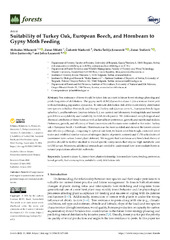Приказ основних података о документу
Suitability of Turkey Oak, European Beech, and Hornbeam to Gypsy Moth Feeding
| dc.creator | Milanović, Slobodan | |
| dc.creator | Miletić, Zoran | |
| dc.creator | Marković, Čedomir | |
| dc.creator | Šešlija Jovanović, Darka | |
| dc.creator | Trailović, Zoran | |
| dc.creator | Jankovský, Libor | |
| dc.creator | Lazarević, Jelica | |
| dc.date.accessioned | 2022-07-06T10:35:19Z | |
| dc.date.available | 2022-07-06T10:35:19Z | |
| dc.date.issued | 2022 | |
| dc.identifier.issn | 1999-4907 | |
| dc.identifier.uri | http://radar.ibiss.bg.ac.rs/handle/123456789/5014 | |
| dc.description.abstract | Pest resistance of trees should be taken into account in future forest strategy planning and predicting risks of defoliation. The gypsy moth (GM) (Lymantria dispar L.) is a serious forest pest with outbreaking population dynamics. To estimate defoliation risk of the most widely distributed tree species in Balkan Peninsula and Europe (Turkey oak Quercus cerris L., European beech Fagus sylvatica L. and hornbeam Carpinus betulus L.), we carried out laboratory feeding trials and investigated their acceptability and suitability for GM development. We determined morphological and chemical attributes of these hosts as well as larval host preference, growth and nutritional indices. Preference, growth, and efficiency of food conversion into biomass were ranked in the order: Turkey oak > European beech > hornbeam. Hornbeam was the most avoided and showed the lowest conversion efficiency although, comparing to optimal oak host, its leaves were less tough, contained more water and exhibited similar values of nitrogen (index of protein content) and C/N ratio (index of investment into carbon based plant defense). We suggest that hornbeam and beech leaf chemical profiles should be further studied to reveal specific compounds that impose high metabolic cost to GM larvae. Moreover, additional research are needed to understand how intermediate hosts in natural populations affect GM outbreaks. | sr |
| dc.language.iso | en | sr |
| dc.publisher | Basel: MDPI | sr |
| dc.relation | info:eu-repo/grantAgreement/MESTD/inst-2020/200007/RS// | sr |
| dc.relation | info:eu-repo/grantAgreement/MESTD/inst-2020/200169/RS// | sr |
| dc.rights | openAccess | sr |
| dc.rights.uri | https://creativecommons.org/licenses/by/4.0/ | |
| dc.source | Forests | sr |
| dc.subject | Lymantria dispar L. | sr |
| dc.subject | Insect–host plant relationship | sr |
| dc.subject | Intermediate hosts | sr |
| dc.subject | Feeding preference | sr |
| dc.subject | Larval growth | sr |
| dc.subject | Leaf consumption | sr |
| dc.subject | Metabolic cost | sr |
| dc.subject | Defoliation risk | sr |
| dc.title | Suitability of Turkey Oak, European Beech, and Hornbeam to Gypsy Moth Feeding | sr |
| dc.type | article | sr |
| dc.rights.license | BY | sr |
| dc.rights.holder | © 2022 by the authors. Licensee MDPI, Basel, Switzerland | sr |
| dc.citation.issue | 7 | |
| dc.citation.volume | 13 | |
| dc.identifier.doi | 10.3390/f13071006 | |
| dc.identifier.scopus | 2-s2.0-85133326191 | |
| dc.identifier.wos | 000834400900001 | |
| dc.citation.apa | Milanović, S., Miletić, Z., Marković, Č., Šešlija Jovanović, D., Trailović, Z., Jankovský, L., et al. (2022). Suitability of Turkey Oak, European Beech, and Hornbeam to Gypsy Moth Feeding. Forests, 13(7), 1006. | |
| dc.citation.vancouver | Milanović S, Miletić Z, Marković Č, Šešlija Jovanović D, Trailović Z, Jankovský L, Lazarević J. Suitability of Turkey Oak, European Beech, and Hornbeam to Gypsy Moth Feeding. Forests. 2022;13(7):1006. | |
| dc.citation.spage | 1006 | |
| dc.type.version | publishedVersion | sr |
| dc.identifier.fulltext | https://radar.ibiss.bg.ac.rs/bitstream/id/10743/bitstream_10743.pdf | |
| dc.citation.rank | M21 |

